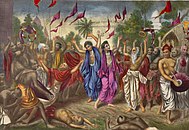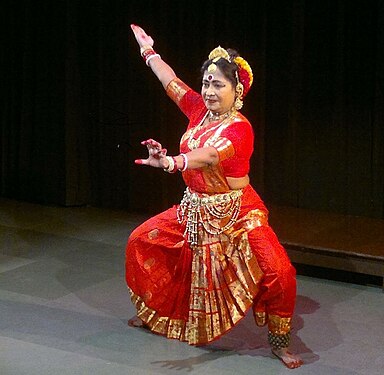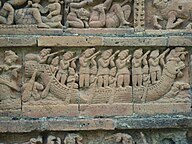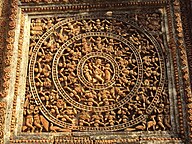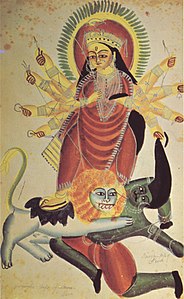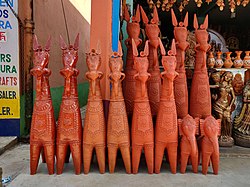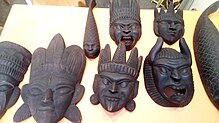Arts of West Bengal: Difference between revisions
>GreenC bot (Rescued 1 archive link; reformat 1 link. Wayback Medic 2.5) |
(robot: Update article (please report if you notice any mistake or error in this edit)) |
||
| Line 1: | Line 1: | ||
{{Short description|Cultural heritage of West Bengal}} | |||
{{Culture of Bengal}} | {{Culture of Bengal}} | ||
{{Use Indian English|date=October 2019}} | {{Use Indian English|date=October 2019}} | ||
{{Use dmy dates|date=October 2019}} | {{Use dmy dates|date=October 2019}} | ||
The [[India]]n state, [[West Bengal]] has a rich cultural heritage. Due to the reign of many different rulers in the past, arts and crafts in [[West Bengal]] underwent many changes giving an artistic diversity today in the forms of traditional handicrafts, terracotta, painting and carving, | The [[India]]n state, [[West Bengal]] has a rich and cultural heritage. Due to the reign of many different rulers in the past, arts and crafts in [[West Bengal]] underwent many changes giving an artistic diversity today in the forms of traditional handicrafts, terracotta, painting and carving, dances, music except of natural beauty and glorious past the state has the strong hold of art and architecture which made the state so unique. | ||
==Music== | ==Music== | ||
| Line 14: | Line 15: | ||
}} | }} | ||
The music of [[West Bengal]] includes multiple [[Bengali Music|indigenous]] musical genres such as [[Baul]], [[Bishnupur Gharana|Bishnupuri Classical]], [[Kirtan]], [[Shyama Sangeet]], [[Rabindra Sangeet]], [[Nazrul Geeti]], Atulprasadi, Dwijendrageeti, Probhati | The music of [[West Bengal]] includes multiple [[Bengali Music|indigenous]] musical genres such as [[Baul]], [[Bishnupur Gharana|Bishnupuri Classical]], [[Kirtan]], [[Shyama Sangeet]], [[Rabindra Sangeet]], [[Nazrul Geeti]], Atulprasadi, Dwijendrageeti, Probhati Sangeet, Kantageeti, Ganasangeet, Adhunik Gaan, [[Rock music of West Bengal|Bengali rock]] etc. West Bengal has a rich culture with the classical and folk songs. | ||
The [[Bishnupur Gharana]] is the sole [[Indian Classical Music|Classical]] (''[[Drupad]]'') ''[[gharana]]'' of [[Bengal]]. It originated in [[Bishnupur, Bankura]] by the court musicians of the [[History of Bankura district#Bishnupur kingdom|Malla Kings]].<ref name=Kings>{{cite web|url=http://www.westbengaltourism.gov.in/web/guest/bishnupur-culture|title=Culture of Bishnupur|access-date=2011-12-05|archive-url=https://web.archive.org/web/20120205193939/http://www.westbengaltourism.gov.in/web/guest/bishnupur-culture|archive-date=2012-02-05|url-status=dead}}</ref> The bauls are a mystic group of singers and musicals, immensely popular in the countryside. They perform using a [[khamak]], [[ektara]] and [[dotara]]. [[Rabindra Sangeet]], also known as Tagore songs, are songs written and composed by [[Rabindranath Tagore]].<ref name="Sigi 2006">{{cite book|last=Sigi|first=Rekha|title=Gurudev Ravindra Nath Tagore A Biography|url=https://books.google.com/books?id=ZW93OdoQIfIC&pg=PA90|year=2006|publisher=Diamond Pocket Books (P) Ltd.|isbn=978-81-89182-90-8|page=90}}</ref> They have distinctive characteristics in the [[music of Bengal]], popular in [[India]] and [[Bangladesh]].<ref name="Tagore 2007">{{cite book|last=Tagore|first=Rabindranath|title=Boyhood Days|url=https://books.google.com/books?id=UWhnwlQyplEC&pg=PR12|year=2007|publisher=Penguin Books India|isbn=978-0-14-333021-9|page=xii}}</ref><ref name="Magic of Rabindra Sangeet">{{cite news|title=Magic of Rabindra Sangeet|url=http://www.deccanherald.com/content/66947/magic-rabindra-sangeet.html|access-date=9 July 2013|newspaper=[[Deccan Herald]]|archive-url=https://web.archive.org/web/20130927055956/http://www.deccanherald.com/content/66947/magic-rabindra-sangeet.html|archive-date=27 September 2013|url-status=dead|df=dmy-all}}</ref> Rabindra Sangeet has been an integral part of Bengal culture for over a century.<ref name="Magic of Rabindra Sangeet" /><ref name="Dasgupta Guha p252">{{cite book|last1=Dasgupta|first1=Sanjukta|last2=Guha|first2=Chinmoy|title=Tagore-At Home in the World|url=https://books.google.com/books?id=8zfX4llLjyUC&pg=PA252|year=2013|publisher=SAGE Publications|isbn=978-81-321-1084-2|page=252}}</ref> Shyama Sangeet is a genre of [[Bengali language|Bengali]] devotional songs dedicated to the Hindu goddess Shyama or [[Kali]] which is a form of supreme universal mother-goddess Durga or parvati. It is also known as Shaktagiti or Durgastuti. | The [[Bishnupur Gharana]] is the sole [[Indian Classical Music|Classical]] (''[[Drupad]]'') ''[[gharana]]'' of [[Bengal]]. It originated in [[Bishnupur, Bankura]] by the court musicians of the [[History of Bankura district#Bishnupur kingdom|Malla Kings]].<ref name=Kings>{{cite web|url=http://www.westbengaltourism.gov.in/web/guest/bishnupur-culture|title=Culture of Bishnupur|access-date=2011-12-05|archive-url=https://web.archive.org/web/20120205193939/http://www.westbengaltourism.gov.in/web/guest/bishnupur-culture|archive-date=2012-02-05|url-status=dead}}</ref> The bauls are a mystic group of singers and musicals, immensely popular in the countryside. They perform using a [[khamak]], [[ektara]] and [[dotara]]. [[Rabindra Sangeet]], also known as Tagore songs, are songs written and composed by [[Rabindranath Tagore]].<ref name="Sigi 2006">{{cite book|last=Sigi|first=Rekha|title=Gurudev Ravindra Nath Tagore A Biography|url=https://books.google.com/books?id=ZW93OdoQIfIC&pg=PA90|year=2006|publisher=Diamond Pocket Books (P) Ltd.|isbn=978-81-89182-90-8|page=90}}</ref> They have distinctive characteristics in the [[music of Bengal]], popular in [[India]] and [[Bangladesh]].<ref name="Tagore 2007">{{cite book|last=Tagore|first=Rabindranath|title=Boyhood Days|url=https://books.google.com/books?id=UWhnwlQyplEC&pg=PR12|year=2007|publisher=Penguin Books India|isbn=978-0-14-333021-9|page=xii}}</ref><ref name="Magic of Rabindra Sangeet">{{cite news|title=Magic of Rabindra Sangeet|url=http://www.deccanherald.com/content/66947/magic-rabindra-sangeet.html|access-date=9 July 2013|newspaper=[[Deccan Herald]]|archive-url=https://web.archive.org/web/20130927055956/http://www.deccanherald.com/content/66947/magic-rabindra-sangeet.html|archive-date=27 September 2013|url-status=dead|df=dmy-all}}</ref> Rabindra Sangeet has been an integral part of Bengal culture for over a century.<ref name="Magic of Rabindra Sangeet" /><ref name="Dasgupta Guha p252">{{cite book|last1=Dasgupta|first1=Sanjukta|last2=Guha|first2=Chinmoy|title=Tagore-At Home in the World|url=https://books.google.com/books?id=8zfX4llLjyUC&pg=PA252|year=2013|publisher=SAGE Publications|isbn=978-81-321-1084-2|page=252}}</ref> Shyama Sangeet is a genre of [[Bengali language|Bengali]] devotional songs dedicated to the Hindu goddess Shyama or [[Kali]] which is a form of supreme universal mother-goddess Durga or parvati. It is also known as Shaktagiti or Durgastuti. | ||
| Line 20: | Line 21: | ||
[[Kirtan]] is also a true song which describe the mythological epic. [[Chaitanya Mahaprabhu]] starts the Hare Krishna movement from [[Nabadwip]]. | [[Kirtan]] is also a true song which describe the mythological epic. [[Chaitanya Mahaprabhu]] starts the Hare Krishna movement from [[Nabadwip]]. | ||
Other songs like Hapu song, Bhadu song, [[Gombhira]], Tusu song, Bhatiyali song, [[Patua Sangeet]], Bolan Song etc. are the true Bengali folk | Other songs like Hapu song, Bhadu song, [[Gombhira]], Tusu song, Bhatiyali song, [[Patua Sangeet]], Bolan Song etc. are the true Bengali folk songs that make the mix of the cultural songs of [[West Bengal]]. | ||
==Dance== | ==Dance== | ||
| Line 55: | Line 56: | ||
It has been reconstructed by [[Mahua Mukherjee]].<ref name=kumu>{{cite news|first=Kumudha |last=Bharatram |url=http://www.thehindu.com/features/friday-review/dance/dance-of-the-ancients/article1608014.ece |title=Dance of the ancients |newspaper=The Hindu |date=April 9, 2011 |access-date=November 15, 2013}}</ref><ref name=anjana>{{cite news|last=Rajan |first=Anjana |url=http://www.hindu.com/ms/2006/12/26/stories/2006122600040100.htm|archive-url=https://web.archive.org/web/20121108051652/http://www.hindu.com/ms/2006/12/26/stories/2006122600040100.htm|url-status=dead|archive-date=November 8, 2012|work=[[The Hindu]] |title=The wheel has come full circle|date=December 26, 2006 }}</ref> It is not recognised as an [[Indian classical dance]] by the [[Sangeet Natak Akademi]],<ref name=anjana/> but study of it is eligible for scholarships from the [[Ministry of Culture (India)|Ministry of Culture]] of India.<ref>{{cite web|url=http://indiaculture.nic.in/indiaculture/scholarship-to-young-artist.html|title=Scholarship to Young Artistes, 2005|publisher=Ministry of Culture. Government of India|url-status=dead|archive-url=https://web.archive.org/web/20131021161953/http://indiaculture.nic.in/indiaculture/scholarship-to-young-artist.html|archive-date=October 21, 2013|df=mdy-all}}</ref> Scholarly reception of the reconstruction ranges from caution to scepticism.<ref name=utpal>Utpal Kumar Banerjee (2006). [https://books.google.com/books?id=RdsJAQAAMAAJ&focus=searchwithinvolume&q=mahua+mukherjee ''Indian performing arts: a mosaic'']. New Delhi: Harman Publishing House. {{ISBN|9788186622759}}. p. 79: "re-creating Gaudiya Nritya as one of the acceptable classical styles will need a formal framework".</ref><ref name=leela>Leela Venkataraman (2006). [https://www.jstor.org/stable/23005939 Negotiating the Extremes: dance]. ''India International Centre Quarterly'', '''33''' (1): 93-102. {{subscription required}} "one may have reservations about the classical dance repertoire visualised by [Mukherjee]".</ref><ref name=roma>Roma Chatterji (2005). p. 9: "Mukherjee tries to reconstitute a Bengali aesthetic within the perspective of pan-Indian civilisation".</ref><ref name=susan>Susan Leigh Foster (2009). [https://books.google.com/books?id=xfvzAAAAMAAJ&focus=searchwithinvolume&q=gaudiya+nritya ''Worlding dance: Studies in international performance'']. Basingstoke; New York: Palgrave Macmillan. {{ISBN|9780230205949}}. p. 125: "I urgently distance my project from that of Kolkata-based scholar, Mahua Mukherjee".</ref> | It has been reconstructed by [[Mahua Mukherjee]].<ref name=kumu>{{cite news|first=Kumudha |last=Bharatram |url=http://www.thehindu.com/features/friday-review/dance/dance-of-the-ancients/article1608014.ece |title=Dance of the ancients |newspaper=The Hindu |date=April 9, 2011 |access-date=November 15, 2013}}</ref><ref name=anjana>{{cite news|last=Rajan |first=Anjana |url=http://www.hindu.com/ms/2006/12/26/stories/2006122600040100.htm|archive-url=https://web.archive.org/web/20121108051652/http://www.hindu.com/ms/2006/12/26/stories/2006122600040100.htm|url-status=dead|archive-date=November 8, 2012|work=[[The Hindu]] |title=The wheel has come full circle|date=December 26, 2006 }}</ref> It is not recognised as an [[Indian classical dance]] by the [[Sangeet Natak Akademi]],<ref name=anjana/> but study of it is eligible for scholarships from the [[Ministry of Culture (India)|Ministry of Culture]] of India.<ref>{{cite web|url=http://indiaculture.nic.in/indiaculture/scholarship-to-young-artist.html|title=Scholarship to Young Artistes, 2005|publisher=Ministry of Culture. Government of India|url-status=dead|archive-url=https://web.archive.org/web/20131021161953/http://indiaculture.nic.in/indiaculture/scholarship-to-young-artist.html|archive-date=October 21, 2013|df=mdy-all}}</ref> Scholarly reception of the reconstruction ranges from caution to scepticism.<ref name=utpal>Utpal Kumar Banerjee (2006). [https://books.google.com/books?id=RdsJAQAAMAAJ&focus=searchwithinvolume&q=mahua+mukherjee ''Indian performing arts: a mosaic'']. New Delhi: Harman Publishing House. {{ISBN|9788186622759}}. p. 79: "re-creating Gaudiya Nritya as one of the acceptable classical styles will need a formal framework".</ref><ref name=leela>Leela Venkataraman (2006). [https://www.jstor.org/stable/23005939 Negotiating the Extremes: dance]. ''India International Centre Quarterly'', '''33''' (1): 93-102. {{subscription required}} "one may have reservations about the classical dance repertoire visualised by [Mukherjee]".</ref><ref name=roma>Roma Chatterji (2005). p. 9: "Mukherjee tries to reconstitute a Bengali aesthetic within the perspective of pan-Indian civilisation".</ref><ref name=susan>Susan Leigh Foster (2009). [https://books.google.com/books?id=xfvzAAAAMAAJ&focus=searchwithinvolume&q=gaudiya+nritya ''Worlding dance: Studies in international performance'']. Basingstoke; New York: Palgrave Macmillan. {{ISBN|9780230205949}}. p. 125: "I urgently distance my project from that of Kolkata-based scholar, Mahua Mukherjee".</ref> | ||
[[File:Dhali Dance.jpg|thumb|Dhali Dance performance]] | |||
===Martial Dances=== | ===Martial Dances=== | ||
| Line 124: | Line 127: | ||
[[File:Chalchitra Kumartuli, Kolkata.jpg|thumb|[[Chalchitra]], a part of Bengal Patachitra, referred to the background Patachitra of the [[Durga]] Pratima]] | [[File:Chalchitra Kumartuli, Kolkata.jpg|thumb|[[Chalchitra]], a part of Bengal Patachitra, referred to the background Patachitra of the [[Durga]] Pratima]] | ||
[[Chalchitra]] is a part of ''Bengal Patachitra'', It referred to the ''Debi Chal'' or ''Durga chala'', the background of the [[Durga]] Pratima or idol.<ref>{{Cite book|title=Paschimbanger lokoshilpa o lokosamaj|last=tarapada santra|publisher=Kolkata: lokosanskriti o adibasi sanskriti kendra|year=2000|location=Kolkata|pages=12}}</ref> [[Patua]], the artists of Chalchitra called it as '''Pata Lekha''', means the writing of Patachitra.<ref name="Giusti, M 2014">Giusti, M. and Chakraborty, U. (ed.). ''Immagini Storie Parole. Dialoghi di formazione coi dipinti cantati delle donne Chitrakar del West Bengal''. Mantova: Universitas Studiorum, 2014, {{ISBN|978-88-97683-39-1}}</ref> 300–400 years old idols of [[Shakta Rash|Nabadwip Shakta Rash]] used Chalchitra as a part of Pratima. At a time, the use of Chalchitra became fade, but now it has a great popularity.<ref>{{Cite news|url=http://www.anandabazar.com/district/nadia-murshidabad/portrait-art-s-demand-at-nabadwip-1.700221|title=পটচিত্রের চাহিদা বাড়ছে নবদ্বীপের রাসে|last=বন্দ্যোপাধ্যায়|first=দেবাশিস|work=Anandabazar Patrika|access-date=2018-04-14|language=bn-IN}}</ref> Chalchitra artist of [[Nabadwip]], Tapan Bhattacharya said- | [[Chalchitra]] is a part of ''Bengal Patachitra'', It referred to the ''Debi Chal'' or ''Durga chala'', the background of the [[Durga]] Pratima or idol.<ref>{{Cite book|title=Paschimbanger lokoshilpa o lokosamaj|last=tarapada santra|publisher=Kolkata: lokosanskriti o adibasi sanskriti kendra|year=2000|location=Kolkata|pages=12}}</ref> [[Patua]], the artists of Chalchitra called it as '''Pata Lekha''', means the writing of Patachitra.<ref name="Giusti, M 2014">Giusti, M. and Chakraborty, U. (ed.). ''Immagini Storie Parole. Dialoghi di formazione coi dipinti cantati delle donne Chitrakar del West Bengal''. Mantova: Universitas Studiorum, 2014, {{ISBN|978-88-97683-39-1}}</ref> 300–400 years old idols of [[Shakta Rash|Nabadwip Shakta Rash]] used Chalchitra as a part of Pratima. At a time, the use of Chalchitra became fade, but now it has a great popularity.<ref>{{Cite news|url=http://www.anandabazar.com/district/nadia-murshidabad/portrait-art-s-demand-at-nabadwip-1.700221|title=পটচিত্রের চাহিদা বাড়ছে নবদ্বীপের রাসে|last=বন্দ্যোপাধ্যায়|first=দেবাশিস|work=Anandabazar Patrika|access-date=2018-04-14|language=bn-IN}}</ref> Chalchitra artist of [[Nabadwip]], Tapan Bhattacharya said- | ||
{{cquote| | {{cquote||Tapan Bhattacharya}} | ||
====Durga pot==== | ====Durga pot==== | ||
| Line 143: | Line 146: | ||
===Dokra=== | ===Dokra=== | ||
Dokra art is the most interesting and creative art of West Bengal. The Dokras are now dispersed over the western part of West Bengal in four districts namely Bankura, Purulia, Midnapore and Burdwan and are mainly concentrated in Bankura and partly in Purulia. The Dokra artisans of Bankura make various kinds of images and figurines of gods and goddesses, birds and animals, like Lakshmi, Lakshmi-Narayan, Shiva-Parvati flanked by Ganesh and Kartik, elephants, horses, owls, peacocks etc.<ref>http://www.chitrolekha.com/V1/n2/03_Dhokra-art-artists-Bikna.pdf</ref> | Dokra art is the most interesting and creative art of West Bengal. The Dokras are now dispersed over the western part of West Bengal in four districts namely Bankura, Purulia, Midnapore and Burdwan and are mainly concentrated in Bankura and partly in Purulia. The Dokra artisans of Bankura make various kinds of images and figurines of gods and goddesses, birds and animals, like Lakshmi, Lakshmi-Narayan, Shiva-Parvati flanked by Ganesh and Kartik, elephants, horses, owls, peacocks etc.<ref>http://www.chitrolekha.com/V1/n2/03_Dhokra-art-artists-Bikna.pdf {{Bare URL PDF|date=March 2022}}</ref> | ||
===Wooden art=== | ===Wooden art=== | ||
| Line 155: | Line 158: | ||
}} | }} | ||
Wooden art is a very old tradition of West Bengal. Wooden protima or idol is seen in Indian Museum. The art-making wooden dolls have been an age-old practice in West Bengal and Natungram is one of them. Natungram, a village of West Bengal makes wooden dolls like Gouranga, Krishna, Bor-Bou, Gour-Nitai, owl etc.<ref>{{Cite news|url=https://seemaawasthiblog.wordpress.com/2016/08/06/natungram-of-bardhaman-district-is-the-hub-for-wooden-doll-making-in-west-bengal/|title=Natungram of Bardhaman district is the hub for wooden doll making in West Bengal.|date=2016-08-06|work=Hand Made Toys|access-date=2018-04-25|language=en-US}}</ref> Gomira masks of [[Uttar Dinajpur district|North]] and [[Dakshin Dinajpur district|South Dinajpur]] in [[West Bengal]] are also made of wood.<ref>http://museumsofindia.gov.in/repository/record/im_kol-79-16-5341</ref><ref>{{Cite news|url=http://www.thehindu.com/news/cities/kolkata/last-of-the-gomira-mask-makers-see-silver-lining/article19242786.ece|title=Last of the Gomira mask-makers see silver lining|last=Singh|first=Shiv Sahay|date=2017-07-09|work=The Hindu|access-date=2018-04-25|language=en-IN|issn=0971-751X}}</ref> | Wooden art is a very old tradition of West Bengal. Wooden protima or idol is seen in Indian Museum. The art-making wooden dolls have been an age-old practice in West Bengal and Natungram is one of them. Natungram, a village of West Bengal makes wooden dolls like Gouranga, Krishna, Bor-Bou, Gour-Nitai, owl etc.<ref>{{Cite news|url=https://seemaawasthiblog.wordpress.com/2016/08/06/natungram-of-bardhaman-district-is-the-hub-for-wooden-doll-making-in-west-bengal/|title=Natungram of Bardhaman district is the hub for wooden doll making in West Bengal.|date=2016-08-06|work=Hand Made Toys|access-date=2018-04-25|language=en-US}}</ref> Gomira masks of [[Uttar Dinajpur district|North]] and [[Dakshin Dinajpur district|South Dinajpur]] in [[West Bengal]] are also made of wood.<ref>{{Cite web|url=http://museumsofindia.gov.in/repository/record/im_kol-79-16-5341|title = Mask of Siknidhal (A malevolent deity)}}</ref><ref>{{Cite news|url=http://www.thehindu.com/news/cities/kolkata/last-of-the-gomira-mask-makers-see-silver-lining/article19242786.ece|title=Last of the Gomira mask-makers see silver lining|last=Singh|first=Shiv Sahay|date=2017-07-09|work=The Hindu|access-date=2018-04-25|language=en-IN|issn=0971-751X}}</ref> | ||
===Bamboo craft=== | ===Bamboo craft=== | ||
| Line 167: | Line 170: | ||
{{clear}} | {{clear}} | ||
==References== | ==References== | ||
{{reflist}} | {{reflist}} | ||
{{Commons category|Arts of West Bengal}} | {{Commons category|Arts of West Bengal}} | ||
Latest revision as of 10:02, 14 March 2022
The Indian state, West Bengal has a rich and cultural heritage. Due to the reign of many different rulers in the past, arts and crafts in West Bengal underwent many changes giving an artistic diversity today in the forms of traditional handicrafts, terracotta, painting and carving, dances, music except of natural beauty and glorious past the state has the strong hold of art and architecture which made the state so unique.
Music[edit]
The music of West Bengal includes multiple indigenous musical genres such as Baul, Bishnupuri Classical, Kirtan, Shyama Sangeet, Rabindra Sangeet, Nazrul Geeti, Atulprasadi, Dwijendrageeti, Probhati Sangeet, Kantageeti, Ganasangeet, Adhunik Gaan, Bengali rock etc. West Bengal has a rich culture with the classical and folk songs.
The Bishnupur Gharana is the sole Classical (Drupad) gharana of Bengal. It originated in Bishnupur, Bankura by the court musicians of the Malla Kings.[1] The bauls are a mystic group of singers and musicals, immensely popular in the countryside. They perform using a khamak, ektara and dotara. Rabindra Sangeet, also known as Tagore songs, are songs written and composed by Rabindranath Tagore.[2] They have distinctive characteristics in the music of Bengal, popular in India and Bangladesh.[3][4] Rabindra Sangeet has been an integral part of Bengal culture for over a century.[4][5] Shyama Sangeet is a genre of Bengali devotional songs dedicated to the Hindu goddess Shyama or Kali which is a form of supreme universal mother-goddess Durga or parvati. It is also known as Shaktagiti or Durgastuti.
Kirtan is also a true song which describe the mythological epic. Chaitanya Mahaprabhu starts the Hare Krishna movement from Nabadwip.
Other songs like Hapu song, Bhadu song, Gombhira, Tusu song, Bhatiyali song, Patua Sangeet, Bolan Song etc. are the true Bengali folk songs that make the mix of the cultural songs of West Bengal.
Dance[edit]
Songs and dances are connected with each to each. The rich cultural heritage and creative minds of the people of Bengal are best reflected in their traditional folk dances like martial dance, harvest dance etc. In Modern West Bengal rural Bengal takes the lead in keeping the old customs and the associated song and dance. The folk dances of West Bengal deals with a variety of themes. Some are associated with religion, prayers, festivals and rituals, others talk about the society.[6]
Gaudiya Nritya[edit]
Gaudiya Nritya (Bengali: গৌড়ীয় নৃত্য) or Gauriya Nritya, is a Bengali classical dance tradition.[7][8][9] It originates from Gauda, also known as Gaur, in Bengal.[10]
It has been reconstructed by Mahua Mukherjee.[9][11] It is not recognised as an Indian classical dance by the Sangeet Natak Akademi,[11] but study of it is eligible for scholarships from the Ministry of Culture of India.[12] Scholarly reception of the reconstruction ranges from caution to scepticism.[13][14][15][16]
Martial Dances[edit]
As a cultural tradition there are many Bengali folk dances describing the mythological wars. This martial or war dances are Purulia Chhau dance, Raibenshe dance, Stick dance or Laghur Nritya, Ranapa Dance, Dhali and Paika Nritya, Kukri Nritya etc.[17]
Harvest Dances[edit]
The cultural folk dance is mostly related with seasons, sowing of seeds, rains, harvesting in West Bengal. It is celebrated with a lot of ardor by village folks, especially the farming community. Gombhira dance of Malda district is associated with mythology. Tushu dance, Nabanna dance, Nnoila broto etc. are also related with farming. Some tribal dance like Santhali dance, Rabha dance, Mundari dance, Rajbanshi dance etc. performed to the accompaniment of a number of musical instrument and are quite elaborated in nature.[18]
Masks[edit]
Mask or Mukhosh of West Bengal, as it known has a mysterious history. Mostly it uses for the Mask Dance, the folk dance of West Bengal. The wearing of these masks is connected with early types of folklore and religion. There is various type of masks made up of clay, wood, sponge wood or shola, pith, paper, metal etc. Generally, half masks are made up of clay, pith and paper and wooden masks are very rare. Some of the masks came from the Tribal of West Bengal. Geographically, West Bengal comes well within this mask using culture zone. Mask in West Bengal is mostly used in folk dance.[19][20] UNESCO selected The Rural Craft Hub of Bengal to showcase their artwork in Paris in 2015.[21]
Chhau Mask[edit]
The most interesting fact, Purulia Chhau Dance is listed on UNESCO's world heritage list of dances.[22] The main difference between the Purulia chhau and Orisha chhau is in the use of the mask. Purulia chhau used the mask in dance, but Orisha does not have the mask thereby adding facial expression with body movement and gesture.[23] Purulia chhau dancers wear the earthy and theatrical mask which represent the mythological characters.
Gambhira Mask[edit]
Gomira mask is a part of Gomira dance which is originated in North and South Dinajpur of West Bengal. The word Gomira is colloquial from Gram-Chandi, a female deity. The extract origin of this craft is no doubt very old and some of the craftsmen claim it is at least as old as the beginning of Kali Yuga. The Gomira dances are organized to propitiate the deity to usher in the good forces and drive out the evil forces.[24] This mask is used in the war dance. It is also called Mukha Khel meaning the game of masks.
Others[edit]
Ghurni region of Krishnanagar has been a notable center of clay art for a long time. Their clay mask of Durga and the other is well known for their beauty and the mask follow a contemporary style. Kolkata Kumartuli is well known for clay mask. The masks are made in clay and then sun-dried and finally coloured and decorated with sponge wood or foil. Potter has been receiving a lot of attention for sculpting Bengali deities. Dokra is unique folk art of West Bengal. Metal casting dokra mask is created various contemporary sculptures with this art form. Gita Karmakar, a female artist from Bankura has been awarded the President's award. Her works of Dokra art are equally popular in other countries. Durga face is a well known shola mask of Murshidabad. It's mainly used for the decorate status. For making this masks, shola is pulled from water and dried. Then it is cut with the knife according to the design. The most attractive fact, Murshidabad is recognize for the shola work.[25]
Terracotta Art[edit]
Architecture[edit]
There are significant examples of fine arts in Bengal from earlier times such as terracotta art of Hindu temples. The roofing style of Bengali Hindu temple architecture is unique and closely related to the paddy roofed traditional building style of rural Bengal.[26] Roofing styles include the jor-bangla, do-chala, char-chala, at-chala, deul, ek-ratna, pancharatna and navaratna. Bishnupur in West Bengal has a remarkable set of such temples which being built from the Malla dynasty are examples of this style. Most of these temples are covered on the outer surface with terracotta reliefs which contains plenty of secular materials making these important to reconstruct the social structure from these times.

The temple structures contain gabled roofs which are colloquially called the chala, For example, a gabled roof with an eight sided pyramid structured roof with be called "ath chala" or literally the eight faces of the roof. And frequently there is more than one tower in the temple building. These are built of laterite and brick bringing them at the mercy of severe weather conditions of southern Bengal. Dakshineswar Kali Temple is one example of the Bhanja style while the additional small temples of Shiva along the river bank are example of southern Bengal roof style though in much smaller dimension.
Terracotta dolls[edit]
Terracotta or clay craft has been the symbol of man's first attempt at craftsmanship, just as the potter's wheel was the first machine invented to use the power of motion for a productive purpose. However, its association with religious rituals has imbibed it with deeper significance. In West Bengal, terracotta traditions are found from the earliest times. They are symbols of fulfillment of aspirations of village folk. In order to cater to the commercial requirements of the modern global market, the village potter is often combining the traditional rural abstractions with refined urban tastes to show pieces of terracotta art.[27]
Bankura Horse[edit]
In Bankura, potters create terracotta horses and elephants. Over the centuries they have moved away from a realistic presentation to a representational presentation. Potter-artists of different regions focused on different parts of the animal body in such a manner that representation of the same became more important than representation of the entire body of the animal.[28]
Manasa chali[edit]

Manasa chali is the idol of Goddess Manasa. It is a unique terracotta sculpture of Panchmura, West Bengal. Manasa chali has a small figure or a group of three figures in the middle, with rows of snake hoods fanning out in a half moon shape.[29]
Painting[edit]
Patachitra[edit]
Patachitra painting is a true cultural heritage of West Bengal. The Patua Community of West Bengal has an ancient history to practiced the craft of Patachitra. A quaint little village of Paschim Medinipur, Naya is home to around 250 Patuas or chitrakars. Bengal Patachitra has a various aspect like Chalchitra, Durga Pat, Medinipur Patachitra, kalighat Patachitra, mud wall painting etc. D. P. Ghosh mentioned different style of Bengal Patachitra respecting of the district of West Bengal in his book Folk Art of Bengal.[30]
The Patachitra of different districts of West Bengal are characterized by many peculiarities in colour and design. The patachitra of Manbhum, now known as Purulia can easily be distinguished by their preference for one particular shade of burnt sienna relieved by white and yellow patches and densely packed composition. The seated figures of Dasaratha and Chand Sadagar of Medinipur crowning the Ramayana and Kamale-Kamini scrolls are impressive and monumental.[30] In the scrolls of pot of Birbhum, Bankura and Burdwan preference for Indian red background usually found, the scrolls of Hooghly preferred a dark brown. The Hooghly and Manbhum 'pats' are peculiar and definitely modernistic with the abstract linear treatment.[31]
Chalchitra[edit]
Chalchitra is a part of Bengal Patachitra, It referred to the Debi Chal or Durga chala, the background of the Durga Pratima or idol.[32] Patua, the artists of Chalchitra called it as Pata Lekha, means the writing of Patachitra.[33] 300–400 years old idols of Nabadwip Shakta Rash used Chalchitra as a part of Pratima. At a time, the use of Chalchitra became fade, but now it has a great popularity.[34] Chalchitra artist of Nabadwip, Tapan Bhattacharya said-
Durga pot[edit]

Durga pot or Durga sara is recognised as the worshiped patachitra. It worshiped in the Hatsarandi Sutradhar society of Birbhum district on Durga puja time. This type of patachitra is also worshiped is Katwa. Durga Pot has a semi-circular Patachitra where Patachitra of Durga is in the middle position. Ram, Sita, Shib, Nandi-Vringi, Brahma, Vishnu, Shumbha-Nishumbha are painted on this kind of Chalchitra. Krishnanager Rajrajeshwari Durga is seen to be uniquely noticed. In the middle of the Chalchitra, there is Panchanan Shib and Parvati is beside him, on one side there is Dasha-mahabidya and the other side, there is Dashabatar.[35]
Handicrafts[edit]
Clay art[edit]
Clay art has an indigenous history in West Bengal. Ghurni of Nadia district is very popular for making the clay idols. West Bengal has an ancient heritage of dolls. Dolls have been customarily crafted by women from the potter communities. Dolls made of soft clay and fired-clay are available all over West Bengal. Each of these dolls are made differently. Terracotta dolls of Panchmura, Hingul and Tusu dolls of Bishnupur, Jo dolls of Midnapore, Kanthalia dolls of Murshidabad, Sasthi dolls of Coonoor, Manasha pot of Dakshindari and Shiva head of Nabadwip are very famous.
Kantha[edit]
Kantha Stitch is one of the most popular handicrafts of Santiniketan in the Birbhum district of West Bengal, India.[36]
Dokra[edit]
Dokra art is the most interesting and creative art of West Bengal. The Dokras are now dispersed over the western part of West Bengal in four districts namely Bankura, Purulia, Midnapore and Burdwan and are mainly concentrated in Bankura and partly in Purulia. The Dokra artisans of Bankura make various kinds of images and figurines of gods and goddesses, birds and animals, like Lakshmi, Lakshmi-Narayan, Shiva-Parvati flanked by Ganesh and Kartik, elephants, horses, owls, peacocks etc.[37]
Wooden art[edit]
Wooden art is a very old tradition of West Bengal. Wooden protima or idol is seen in Indian Museum. The art-making wooden dolls have been an age-old practice in West Bengal and Natungram is one of them. Natungram, a village of West Bengal makes wooden dolls like Gouranga, Krishna, Bor-Bou, Gour-Nitai, owl etc.[38] Gomira masks of North and South Dinajpur in West Bengal are also made of wood.[39][40]
Bamboo craft[edit]
Bamboo crafts are a very old and indigenous tradition in West Bengal. Different shapes and patterns of baskets are made using local traditions and techniques. In West Bengal, a tray-like bamboo basket is traditional. Different types of baskets, hand-held fan, sieves etc. are also made and painted with auspicious symbols and are used in marriage and other ceremonies.[41]
See also[edit]
References[edit]
- ↑ "Culture of Bishnupur". Archived from the original on 5 February 2012. Retrieved 5 December 2011.
- ↑ Sigi, Rekha (2006). Gurudev Ravindra Nath Tagore A Biography. Diamond Pocket Books (P) Ltd. p. 90. ISBN 978-81-89182-90-8.
- ↑ Tagore, Rabindranath (2007). Boyhood Days. Penguin Books India. p. xii. ISBN 978-0-14-333021-9.
- ↑ 4.0 4.1 "Magic of Rabindra Sangeet". Deccan Herald. Archived from the original on 27 September 2013. Retrieved 9 July 2013.
- ↑ Dasgupta, Sanjukta; Guha, Chinmoy (2013). Tagore-At Home in the World. SAGE Publications. p. 252. ISBN 978-81-321-1084-2.
- ↑ "West Bengal Dances - West Bengal Folk Dances, Folk Dances Bengal India". www.bharatonline.com. Retrieved 25 April 2018.
- ↑ Roma Chatterji (2005). Folklore and the Construction of National Tradition Archived 12 February 2018 at the Wayback Machine. Indian Folklife 19 (Folklore Abroad: On the Diffusion and Revision of Sociocultural Categories): 9. Accessed January 2014. "a classical dance tradition that has vanished from the urban areas".
- ↑ "West Bengal Tourism: Dance". Department of Tourism, Government of West Bengal. 2011. Archived from the original on October 21, 2013. Retrieved January 11, 2014.
- ↑ 9.0 9.1 Bharatram, Kumudha (9 April 2011). "Dance of the ancients". The Hindu. Retrieved 15 November 2013.
- ↑ Mukherjee, Mahua (2000). Gaudiya Nritya (in Bengali). Kolkata: The Asiatic Society.
- ↑ 11.0 11.1 Rajan, Anjana (26 December 2006). "The wheel has come full circle". The Hindu. Archived from the original on 8 November 2012.
- ↑ "Scholarship to Young Artistes, 2005". Ministry of Culture. Government of India. Archived from the original on October 21, 2013.
- ↑ Utpal Kumar Banerjee (2006). Indian performing arts: a mosaic. New Delhi: Harman Publishing House. ISBN 9788186622759. p. 79: "re-creating Gaudiya Nritya as one of the acceptable classical styles will need a formal framework".
- ↑ Leela Venkataraman (2006). Negotiating the Extremes: dance. India International Centre Quarterly, 33 (1): 93-102. (subscription required) "one may have reservations about the classical dance repertoire visualised by [Mukherjee]".
- ↑ Roma Chatterji (2005). p. 9: "Mukherjee tries to reconstitute a Bengali aesthetic within the perspective of pan-Indian civilisation".
- ↑ Susan Leigh Foster (2009). Worlding dance: Studies in international performance. Basingstoke; New York: Palgrave Macmillan. ISBN 9780230205949. p. 125: "I urgently distance my project from that of Kolkata-based scholar, Mahua Mukherjee".
- ↑ "West Bengal folk dance". Indian Classical Folk & Tribal Dance. 2 March 2012. Retrieved 25 April 2018.
- ↑ "5 popular folk dances of West Bengal". MYTHICAL INDIA. 11 May 2016. Retrieved 25 April 2018.
- ↑ Masks of West Bengal_Publisher:Indian Museum_kolkata_Author: Sabita Ranjan Sarkar
- ↑ Masks of West Bengal.
- ↑ Roy, Tasmayee Laha (5 February 2016). "West Bengal rural craft hubs help artisans double their incomes". The Economic Times. Retrieved 13 February 2018.
- ↑ "Chhau Dance: West Bengal's Performing Art Treasure | Utsavpedia". Utsavpedia. 30 July 2015. Retrieved 12 February 2018.
- ↑ "The Official Website of Purulia District". purulia.gov.in. Retrieved 12 February 2018.
- ↑ "Mask of Siknidhal (a malevolent deity)". Museum of India.
- ↑ "The Mask". Biswa Bangla. Retrieved 18 April 2018.
- ↑ 3.http://www.kamat.com/kalranga/wb/wbtemps.htm
- ↑ "Arts". Bankura Pottery. Suni Systems (P) Ltd. Retrieved 22 June 2009.
- ↑ Ghosh, Binoy, Paschim Banger Sanskriti, (in Bengali), part I, 1976 edition, pp. 69-71, Prakash Bhaban
- ↑ Dasgupta, Samira; Biswas, Rabiranjan; Mallik, Gautam Kumar (2009). Heritage Tourism: An Anthropological Journey to Bishnupur. Mittal Publications. ISBN 9788183242943.
- ↑ 30.0 30.1 Craft council of west Bengal-1985-86, The Jarana Patachitra of Bengal- Mahamaya, p-112
- ↑ D. P. Ghosh, FOLK ART OF BENGAL, Visvabharati, p-4
- ↑ tarapada santra (2000). Paschimbanger lokoshilpa o lokosamaj. Kolkata: Kolkata: lokosanskriti o adibasi sanskriti kendra. p. 12.
- ↑ Giusti, M. and Chakraborty, U. (ed.). Immagini Storie Parole. Dialoghi di formazione coi dipinti cantati delle donne Chitrakar del West Bengal. Mantova: Universitas Studiorum, 2014, ISBN 978-88-97683-39-1
- ↑ বন্দ্যোপাধ্যায়, দেবাশিস. "পটচিত্রের চাহিদা বাড়ছে নবদ্বীপের রাসে". Anandabazar Patrika (in Bengali). Retrieved 14 April 2018.
- ↑ ভট্টাচার্য, বিভূতিসুন্দর. "অবক্ষয় আর অবলুপ্তির মাঝে বাংলার চালচিত্র - Anandabazar". Anandabazar Patrika. Retrieved 14 April 2018.
- ↑ Roy, Paramita; Biswas, Sattwick Dey. "Opportunities and Constraints of the Kantha-stitch craftswomen in Santiniketan: a value chain analysis". Journal of Social Work and Social Development.
- ↑ http://www.chitrolekha.com/V1/n2/03_Dhokra-art-artists-Bikna.pdf Template:Bare URL PDF
- ↑ "Natungram of Bardhaman district is the hub for wooden doll making in West Bengal". Hand Made Toys. 6 August 2016. Retrieved 25 April 2018.
- ↑ "Mask of Siknidhal (A malevolent deity)".
- ↑ Singh, Shiv Sahay (9 July 2017). "Last of the Gomira mask-makers see silver lining". The Hindu. ISSN 0971-751X. Retrieved 25 April 2018.
- ↑ "Cane & Bamboo of West Bengal | The Craft and Artisans". www.craftandartisans.com. Retrieved 25 April 2018.

